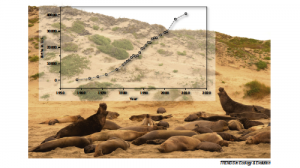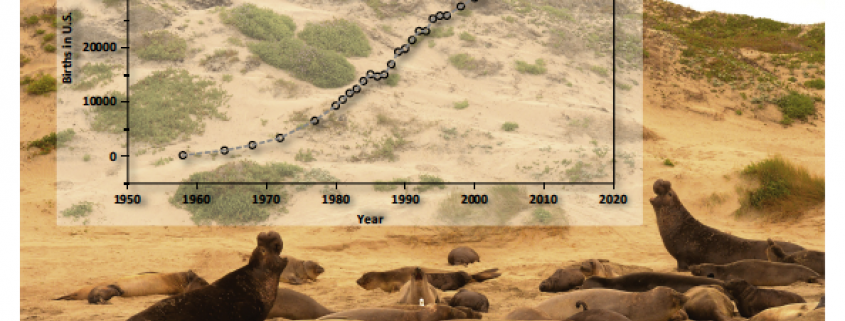Lifting, Not Shifting, Baselines in the Face of Conservation Success
By Kevin Reagan, SRC Intern
Twenty years ago the term “shifting baselines” was explored and coined by a fisheries scientist named Daniel Pauly in his paper titled “Anecdotes and the shifting baseline syndrome of fisheries.” This term is used to describe the idea that with each successive generation, in this case speaking of generations of fisheries scientists, the baseline (or standard) of fish stocks, abundance, size, growth rate, etc. is what they observed in the population at the beginning of their careers. Losses before this time are not really seen as losses because the norm is what’s observed when scientists begin, and this is not necessarily the case; in most instances that number is already far below what historic levels were and not the true baseline that would describe a healthy, fully recovered population. What is even worse is that it shifts with each generation, gradually moving farther away from where it should be and being considered fine.
However, in recent years, certain species of animals are recovering and growing in number, eventually returning to areas they had long been absent from. This is almost always a result of the reduction/banning of commercial hunting, like the Convention on International Trade of Endangered Species, and harmful chemicals like DDT. In this paper, authors propose the idea of “lifting baselines” as part of the shifting baselines syndrome to describe and celebrate conservation success stories. In analysis of trends of 92 different marine species, 42% were increasing in number, 10% were decreasing, and the rest showed no change in status. This is not to say that this is a universal trend; huge numbers of species are still in decline and we are still in the midst of a massive extinction event. Even so, many species are doing better than before. For instance, elephant seals were almost hunted to extinction in the late 1800’s. It is estimated that as few as twenty individuals remained. But, after being protected by Mexico and the U.S. in the 1920’s, their numbers have rebounded to over 200,000 seals.

Northern elephant seal rookery on Año Nuevo Island, CA. The graph depicts the increase in the number of births of elephant seals since 1960.
While the recovery of species is great news for conservation scientists, it is not always welcomed by the public, especially recovery of marine predators. Many maritime industries developed while predators were few and far between and expected them to stay that way. Now that their numbers have rebounded, people believe there to be a surplus regardless of what the numbers were before exploitation (example of shifting baselines). This can result in a call for culling (mass killing) of the animals because they’re considered a nuisance. Lifting baselines, where “successful recovery of depleted species is verified, celebrated, and understood in an ecological and historical context,” can counter this. Authors developed four basic strategic recommendations to lift baselines, develop public support, and create acceptance in the sociopolitical arena around these success stories. They are as follows:
- When protection works, celebrate it!
– Conservation scientists and NGO’s need to actively engage the public in monitoring and recording a species’ return to its previous historic numbers. This creates a positive attitude and a sense of responsibility for the animal’s recovery.
- Down/delist species that no longer require protective measures
– Reward the efforts that reversed the species’ decline and allow the time and resources previously being used to help those species that are still in trouble.
- Actively anticipate and manage potential and actual conflicts that are the result of range expansion and trophic interactions of recovering species.
– Monitor ecological changes and engage stakeholders as part of the recovery strategy. Recovering species will influence other species and the food web as it assumes its role in the environment. Investigating these relationships between species of concern will help develop realistic recovery targets and management goals
- True costs and benefits of removing “nuisance” animals through different means must be established.
– In general, there is very little follow-up after the removal of nuisance animals and cost-benefit analyses are almost never performed. Costs should be quantified and include both ecological and social measures. If the methods used are not cost-effective, a less destructive and invasive approach is needed
These recommendations should be put in place while the initial conservation steps are being taken. Clear and realistic recovery goals can help species move off the endangered species list and accurate estimates of costs/benefits can turn wildlife from a scapegoat to an asset. However, this will require input from more than just scientists. Economists, artists, journalists, and social scientists will all be needed for effective public outreach and conservation measures, especially to reduce conflicts between humans and endangered animals. If we all work together, we can establish conservation plans that are practical, can make a difference, and most importantly, are realistic.
References
Roman, Joe, Meagan M. Dunphy-Daly, David W. Johnston, and Andrew J. Read. “Lifting Baselines to Address the Consequences of Conservation Success.” Trends in Ecology & Evolution 30.6 (2015): 299-302. Web.




Leave a Reply
Want to join the discussion?Feel free to contribute!